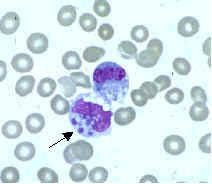Medicine:Human monocytotropic ehrlichiosis
| Human monocytic ehrlichiosis | |
|---|---|
 | |
| Ehrlichia chaffeensis |
Human monocytotropic ehrlichiosis[1] is a form of ehrlichiosis associated with Ehrlichia chaffeensis.[2] This bacterium is an obligate intracellular pathogen affecting monocytes and macrophages.[3]
Symptom and signs
The most common symptoms are fever, headache, malaise, and muscle aches (myalgia). Compared to human granulocytic anaplasmosis, rash is more common.[4] Laboratory abnormalities include thrombocytopenia, leukopenia, and elevated liver tests.[citation needed]
The severity of the illness can range from minor or asymptomatic to life-threatening. CNS involvement may occur. A serious septic or toxic shock-like picture can also develop, especially in patients with impaired immunity.[5]
Cause
This disease is known to be caused by tick bites.[6]
Diagnosis
Tick exposure is often overlooked. For patients living in high-prevalence areas who spend time outdoors, a high degree of clinical suspicion should be employed.[citation needed] Ehrlichia serologies can be negative in the acute period. Polymerase chain reaction is therefore the laboratory diagnostic tool of choice.[7]
Treatment
If ehrlichiosis is suspected, treatment should not be delayed while waiting for a definitive laboratory confirmation, as prompt doxycycline therapy has been associated with improved outcomes.[8] Doxycycline is the treatment of choice.[citation needed]
Presentation during early pregnancy can complicate treatment.[9] Rifampin has been used in pregnancy and in patients allergic to doxycycline.[10]
Epidemiology
In the US, human monocytotropic ehrlichiosis occurs across the south-central, southeastern, and mid-Atlantic states, regions where both the white-tailed deer (Odocoileus virginianus) and Lone Star ticks (Amblyomma americanum) thrive.[citation needed]
Human monocytotropic ehrlichiosis occurs in California in Ixodes pacificus ticks and in Dermacentor variabilis ticks.[11] Nearly 600 cases were reported to the CDC in 2006. In 2001–2002, the incidence was highest in Missouri, Tennessee, and Oklahoma, as well as in people older than 60.[12]
See also
- Human ewingii ehrlichiosis
- Human granulocytic anaplasmosis
- Monocyte
References
- ↑ Rapini, Ronald P.; Bolognia, Jean L.; Jorizzo, Joseph L. (2007). Dermatology. Mosby. pp. 1130. ISBN 978-1-4160-2999-1. https://archive.org/details/dermatologyvolum00mdje.
- ↑ "Human monocytic ehrlichiosis in children". Pediatr. Infect. Dis. J. 26 (6): 475–9. June 2007. doi:10.1097/INF.0b013e318042b66c. PMID 17529862.
- ↑ Zhang, Jian-zhi; Popov, Vsevolod L.; Gao, Si; Walker, David H.; Yu, Xue-jie (March 2007). "The developmental cycle of Ehrlichia chaffeensis in vertebrate cells". Cellular Microbiology 9 (3): 610–618. doi:10.1111/j.1462-5822.2006.00812.x. PMID 16987329.
- ↑ "Human granulocytic anaplasmosis and Anaplasma phagocytophilum". Emerging Infectious Diseases 11 (12): 1828–34. December 2005. doi:10.3201/eid1112.050898. PMID 16485466.
- ↑ "Infections with Ehrlichia chaffeensis and Ehrlichia ewingii in persons coinfected with human immunodeficiency virus". Clinical Infectious Diseases 33 (9): 1586–94. November 2001. doi:10.1086/323981. PMID 11568857. http://digitalcommons.unl.edu/cgi/viewcontent.cgi?article=1058&context=zoonoticspub.
- ↑ "Ehrlichiosis – Transmission". 17 January 2019. https://www.cdc.gov/ehrlichiosis/symptoms/index.html.
- ↑ "Ehrlichiosis: making the diagnosis in the acute setting". Southern Medical Journal 100 (8): 825–8. August 2007. doi:10.1097/smj.0b013e31804aa1ad. PMID 17713310.
- ↑ "The importance of early treatment with doxycycline in human ehrlichiosis". Medicine 87 (2): 53–60. March 2008. doi:10.1097/MD.0b013e318168da1d. PMID 18344803.
- ↑ "Human granulocytic ehrlichiosis complicating early pregnancy". Infect Dis Obstet Gynecol 2008: 1–3. 2008. doi:10.1155/2008/359172. PMID 18509484.
- ↑ "Successful treatment of human granulocytic ehrlichiosis in children using rifampin". Pediatrics 112 (3 Pt 1): e252–3. September 2003. doi:10.1542/peds.112.3.e252. PMID 12949322. http://pediatrics.aappublications.org/cgi/pmidlookup?view=long&pmid=12949322.
- ↑ "Detection of Borrelia burgdorferi, Ehrlichia chaffeensis, and Anaplasma phagocytophilum in ticks (Acari: Ixodidae) from a coastal region of California". J. Med. Entomol. 40 (4): 534–9. July 2003. doi:10.1603/0022-2585-40.4.534. PMID 14680123.
- ↑ "Statistics and Epidemiology: Annual Cases of Ehrlichiosis in the United States". Ehrlichiosis. Division of Vector-Borne Diseases (DVBD), National Center for Emerging and Zoonotic Infectious Diseases (NCEZID), Centers for Disease Control and Prevention. 5 September 2013. https://www.cdc.gov/ehrlichiosis/stats/.
External links
| Classification | |
|---|---|
| External resources |
 |

